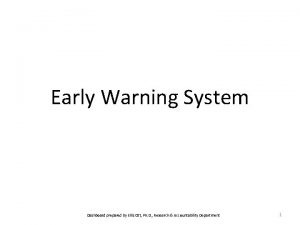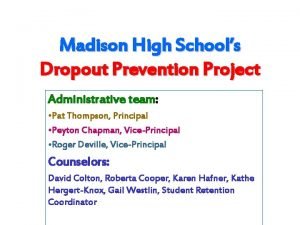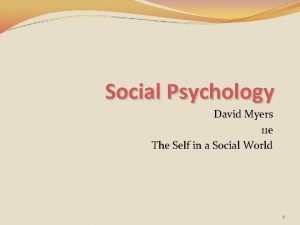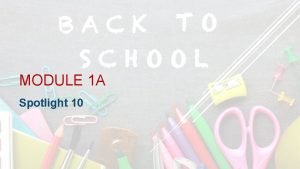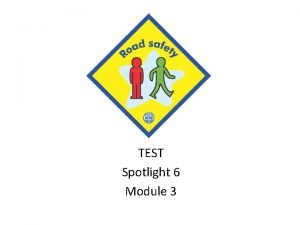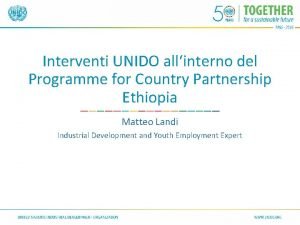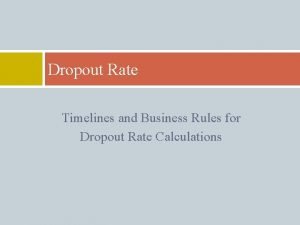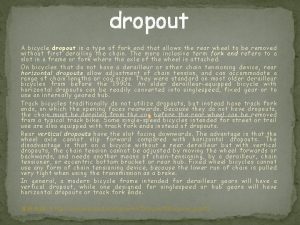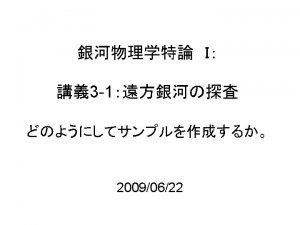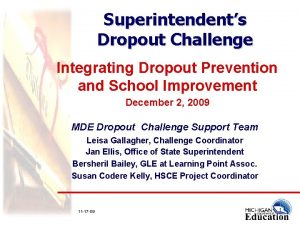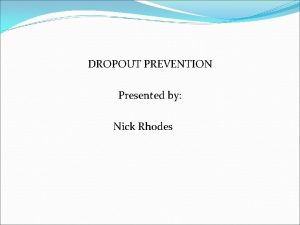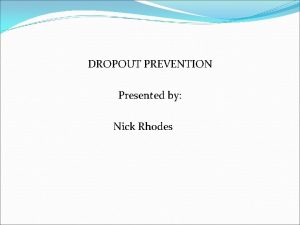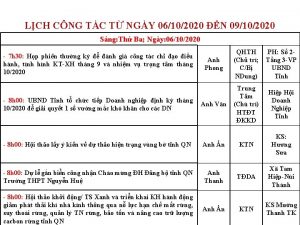SPOTLIGHT ON DROPOUT 06102020 AGENDA PURPOSE OF THE






























































- Slides: 62

SPOTLIGHT ON DROPOUT 06/10/2020

AGENDA PURPOSE OF THE MEETING: 1. Share key research findings 2. Outline strategic options to reduce dropout, and potentially assist with improving other educational outcomes (such as improving teaching and learning, reduce repetition rates, improve school throughput) 3. Provide clear implementation steps based on three years of iterative learning 4. Build a lasting relationship and learning partnership for future collaboration in this area PRESENTERS: MERLE MANSFIELD, Zero Dropout Campaign Programme Director ANGE BIDEN, Policy Consultant

ABOUT THE ZERO DROPOUT CAMPAIGN A national campaign working towards halving the rate of school dropout by 2030 OUR PRIORITIES • Increase national awareness about the problem of school dropout and spur action towards addressing it • Demonstrate what it takes to help children make it through school • Mobilise a network of schools committed to work together to reduce dropout HOW? • We have collaborated with non-profit organisations (NPOs) to test models of intervention • Psychosocial support and data monitoring are central to these interventions

WHAT DOES DISENGAGEMENT LOOK LIKE?


PUSH OUT

POOR TEACHING AND LEARNING PUSH OUT

POOR TEACHING AND LEARNING PUSH OUT POOR LEARNER OUTCOMES (Failure & Repetition, Learners Over Age)

POOR TEACHING AND LEARNING PUSH OUT DISENGAGEMENT POOR LEARNER OUTCOMES (Failure & Repetition, Learners Over Age)

POOR TEACHING AND LEARNING PULL OUT PUSH OUT DISENGAGEMENT POOR LEARNER OUTCOMES (Failure & Repetition, Learners Over Age)

COMMUNITY FACTORS PULL OUT POOR TEACHING AND LEARNING PUSH OUT DISENGAGEMENT POOR LEARNER OUTCOMES (Failure & Repetition, Learners Over Age)

COMMUNITY FACTORS FAMILY FACTORS PULL OUT POOR TEACHING AND LEARNING PUSH OUT DISENGAGEMENT POOR LEARNER OUTCOMES (Failure & Repetition, Learners Over Age)

COMMUNITY FACTORS FAMILY FACTORS PULL OUT DISENGAGEMENT POOR TEACHING AND LEARNING PUSH OUT DISENGAGEMENT POOR LEARNER OUTCOMES (Failure & Repetition, Learners Over Age)

COMMUNITY FACTORS FAMILY FACTORS PULL OUT DISENGAGEMENT POOR TEACHING AND LEARNING PUSH OUT POOR LEARNER OUTCOMES (Failure & Repetition, Learners Over Age) DISENGAGEMENT LEARNER DROPOUT

COMMUNITY FACTORS FAMILY FACTORS PULL OUT DISENGAGEMENT POOR TEACHING AND LEARNING PUSH OUT POOR LEARNER OUTCOMES (Failure & Repetition, Learners Over Age) DISENGAGEMENT LEARNER DROPOUT

COMMUNITY FACTORS FAMILY FACTORS PULL OUT DISENGAGEMENT POOR TEACHING AND LEARNING LEARNER DROPOUT PUSH OUT DISENGAGEMENT POOR LEARNER OUTCOMES (Failure & Repetition, Learners Over Age)

AMY-LEE’S* STORY Amy-Lee is from Lotus River; she is 21 years old and tells us that she dropped out of school in Grade 10 due to a combination of peer pressure and socio-economic circumstances. “My friends really put lots of pressure on me. I’d call them in the morning and say I was going to school and they’d say I was boring. Come on, come on…and then I’d join the click, ” she says. She wants to work towards getting her Senior Certificate by attending a night school, but Amy-Lee lives in a dangerous area and would need to find a safe way to commute to class. “I have so many regrets now. I know that if I’d stayed in school I’d be so far by now. Some of those friends are back at school now and I’m still at home. Some are pregnant. Some are just at home working on their mother’s nerves, ” Amy-Lee laughs. *Not her real name

Solving the dropout crisis lies in providing ongoing psychosocial support, with targeted support by monitoring and tracking learner level data.


TEACHING AND LEARNING DISENGAGEMENT LEARNER OUTCOMES

LEARNER OUTCOMES DISENGAGEMENT TEACHING AND LEARNING

Psychosocial support interventions LEARNER OUTCOMES ENGAGEMENT TEACHING AND LEARNING

Psychosocial support interventions LEARNER OUTCOMES ENGAGEMENT TEACHING AND LEARNING Teaching and learning intervention

NOLUTHANDO’S* STORY Noluthando left school in 2018 due to a combination of peer pressure and a range of complex push-out and pull-out factors in her life. While at home, she became a mother at the age of 15. Luckily, Noluthando was able to turn her situation around. With the help of a supportive mentor, she resumed her schooling with the goal of building a better life for her daughter. “After I had my daughter, the Check & Connect mentor helped me get back to school. She would call me almost every day and encourage me to come back to school. She would tell me to come back, change how I behave and focus on my studies so I can be somebody in the future, ” she says. *Not her real name

PRESENTATION OVERVIEW A national campaign working towards halving the rate of school dropout by 2030 SOUTH AFRICA’S DROPOUT CRISIS • Pervasive and normalised • Perceptions about dropout • The Covid-19 moment BUILDING A RESILIENT EDUCATION SYSTEM • Learner-level data tracking • Efficient referral systems CASE STUDIES RECOMMENDATIONS • Make Dropout reduction a KPI • Improve data and monitoring • Provide psychosocial support

SOUTH AFRICA’S DROPOUT CRISIS

40% Around 40% of learners who start school in Grade 1 will exit the schooling system before completing Grade 12.

SOUTH AFRICA’S DROPOUT CRISIS Pervasive and normalised ! Education sector receives the lion’s share of the government ! Despite this investment, around 40% of learners who start budget (even though funding per learner has been declining) school won’t finish DARK GREY R 69 G 69 B 67 HEX# 454543 ! This has largely been a hidden crisis ! No proper data tracking and monitoring to accurately reflect ! extent of the problem Despite the knock-on effect of dropout on unemployment and social spending, there is no national task team or coordinated effort to tackle the problem

THE TRUE MATRIC PASS RATE OF THE 2008 COHORT The percentage of Grade 1 learners who made it to Grade 12 and beyond

SOUTH AFRICA’S DROPOUT CRISIS Perceptions about dropout • Contrary to popular belief, learners don’t leave school because they are lazy or irresponsible • Dropout is rarely a single event; it’s a cumulative process of disengagement that occurs over time • Disruptions in the home, school and community push and pull the child away from school

BUT… We can catch learners BEFORE they drop out with: ü Early warning systems ü Proper data tracking and monitoring ü Psychosocial support

SOUTH AFRICA’S DROPOUT CRISIS The Covid-19 moment The Covid-19 pandemic (health, economic & social impact) amplifies disruptions that cause dropout NIDS/CRAM survey shows: • Economic impact: 3 million people lost their jobs by April (18% decline compared to February) • Increased hunger: 1 in 2 households (47% of respondents) ran out of money to buy food in April • Health access: 1 in 4 people were unable to access medicine and contraceptives in the 14 days prior to the survey The pandemic has brought dropout into sharp focus The Covid-19 school closures, coupled with the economic shocks of lockdown, are expected to worsen dropout

“Being at home during Covid-19 has been difficult. We were sent work — we picked it up and then dropped it off when we were finished. But it is difficult to adjust without a teacher. Being able to see them and interact with the teachers online would have made the time easier, I think. ” Cassidy, 15, Ottery, Western Cape

“I was trying to adapt. I was trying to cover the time we lost. But since we are closing now I’m not sure whether I will be able to get back on track again” Khanya, 18, Umbumbulu in Kwa-Zulu Natal

BUILDING A RESILIENT EDUCATION SYSTEM

BUILDING A RESILIENT EDUCATION SYSTEM Learner-level data tracking • Research shows that one of the best ways to prevent dropout is through effective monitoring systems • These systems must track learner progress to alert education officials when learners are at risk • What should we be tracking? ABC’s*… • Academic results • Behaviour problems • Chronic Absenteeism * Findings based on international best practice and research on learner disengagement and dropout. (UNESCO Monitoring Education Participation Series)


BUILDING A RESILIENT EDUCATION SYSTEM Efficient referral systems üThrough a referral system, at-risk learners are identified early and given necessary support: • Mentoring • Counselling • Home visits üResearch shows that learners who stay in and do well at school, despite challenging circumstances, often succeed because they have stable, positive emotional relationships with at least one parent or key person üEVERY CHILD NEEDS A CHAMPION! üReferral system would be further strengthened through inter-sectoral collaboration (Health, Soc. Dev & Education)

CASE STUDIES

CASE STUDIES Overview of our implementing partners An initiative that mobilises the community of Swellendam to tackle school dropout as a collective Using Early Warning Systems to support and respond to young people at risk of dropping out Creating opportunities for psychosocial support and academic catch-up in schools Using Child and Youth Care Workers (CYCWs) at schools to provide lower-cost psychosocial support

CASE STUDIES Overview of our implementing partners DARK GREY R 69 G 69 B 67 HEX# 454543

CASE STUDIES EWS risk assessment and SHARED model Holistic community intervention HOW? • By rallying community members and school leadership around the issue of dropout EWS risk assessment HOW? • Six schools able to track and reflect absenteeism from 2018 - 2019 • Track learner-level data with the EWS tool • Two schools monitor all their intermediate phase learners, while others monitor the entire school cohort • With EWS, able to monitor the number of learners who drop out per grade, each quarter, in each school

CASE STUDIES Check & Connect Leveraging EWS and mentorship programme HOW? • Identify at-risk learners in grades 6 - 9 • Connect these learners with mentors • Six schools connected to the Data Driven Districts Dashboard • Principals trained to use the system to track school data

CASE STUDIES Check & Connect Grade 8 Dropout 20% 15% 9% 8% 7% 5% 4% 1% 0% 2016 2017 Mzamowethu Mzokhanyo 2018 Wongalethu

“The check and connect mentorship programme helps because some of them come from parents who are demotivated. When the social worker is helping them you at least see the child is motivated. If I’m having a problem, I’ll ask the social worker to help. She knows how to talk to them. ” Xoliswa Adonis, Grade 7 teacher, Duncan Village

CASE STUDIES Absenteeism tracking and Khula Sayso Instil a culture of learning HOW? • Promote school attendance and value of education Tracking absenteeism HOW? • Mentor schools to track learner attendance accurately and in real-time • Quality data management protocols

CASE STUDIES Absenteeism tracking and Khula Sayso Khula Chronic Absenteeism % of learners chronically absent (5+ days per term) 62. 77% 58. 94% 48. 02% 41. 36% 39. 63% 38. 98% 29. 73% 0 Term 1 '18 0 Term 2 '18 0 Term 3 '18 0 Term 4 '18 0 Term 1 '19 0 Term 2 '19 0 Term 3 '19

CASE STUDIES Isibindi Ezikoleni model Training and capacitating schools HOW? • Prevent dropout by providing a school-based child and youth care service • CYCWs work with Learner Support Agents (LSAs) employed by DBE to support school spaces • DARK GREY R 69 G 69 B 67 HEX# 454543 Tiered approach of intervention 1. Early intervention 2. Full intervention 3. Whole school prevention • Seven schools using the Data Driven Districts Dashboard • Worked with New Leaders Foundation to train principals and school staff on capturing data, however, school capacity for data management is low

“They create a space for us to be able to talk about things, even if they are topics that are sensitive or we feel uncomfortable talking about…they allow us the space that we can actually share and talk to them. ” Ntandokazi, 16, Ntshiyabantu village in Kwa-Zulu Natal

RECOMMENDATIONS

#1. MAKE DROPOUT REDUCTION A KPI

RECOMMENDATION #1 MAKE DROPOUT REDUCTION A KPI What is the status quo? DARK GREY • DBE’s revised five-year strategic plan 2015/16 – 2019/20 mentions R 69 G 69 B 67 HEX# 454543 dropout, with an emphasis on keeping learners engaged up to grade 9 • No target identified for learner dropout • Positions dropout as a concern for learners with special needs

RECOMMENDATION #1 MAKE DROPOUT REDUCTION A KPI The shift we want to see… Make dropout a KPI and set reduction targets ü Dropout prevention strategies are an explicit goal, with feedback required on the development of systems to manage and measure this ü Strong focus on boosting learner engagement ü An understanding that dropout prevention is a mechanism to improve education outcomes, and a range of other KPIs ü Regular discussions about the ‘Care and Support in Schools’ function at national and provincial levels DARK GREY R 69 G 69 B 67 HEX# 454543

#2. IMPROVE DATA AND MONITORING

RECOMMENDATION #2 IMPROVE DATA AND MONITORING What is the status quo? DARK GREY • Some data monitoring taking place with SA-SAMS • Some analysis and SMT feedback and development with DDD • Insufficient psychosocial interventions R 69 G 69 B 67 HEX# 454543

RECOMMENDATION #2 IMPROVE DATA AND MONITORING The shift we want to see… Expedite the SA-SAMS re-write, universalise and link to LURITS ü An individual learner tracking identifier is key to developing data systems for dropout ü Mandate the use of the individual learner tracking number (ID Number) ü Ensure all required indicators are understood, universally defined, properly used and captured on SA-SAMS

RECOMMENDATION #2 IMPROVE DATA AND MONITORING The shift we want to see… Facilitate implementation of improved data practices ü Institutionalise data collection at schools ü Awareness on the importance/value of data for schools ü Infrastructure and human resources needed to fulfil the data management process ü Establish a Learnership on how to use data to design cross-cutting, school-level interventions

RECOMMENDATION #2 IMPROVE DATA AND MONITORING The shift we want to see… Build an early warning system ü With a functional EMIS and right indicators at learner level, design a tool to assess risk based on ABCs ü Create system of alerts for educators ü Create space/time in schools to track ABC indicators, identify learners and develop interventions ü Assess interventions over time

#3. PROVIDE PSYCHOSOCIAL SUPPPORT

RECOMMENDATION #3 PROVIDE PSYCHOSOCIAL SUPPORT What is the status quo? DARK GREY • Although there a range of policies and processes — including White R 69 G 69 B 67 HEX# 454543 Paper 6, the Psychosocial Support Strategy (PSS) and others — there are no explicit plans for systematically ensuring the right support services are available in all schools • Chief Directorate for “Care and Support in Schools”

RECOMMENDATION #3 PROVIDE PSYCHOSOCIAL SUPPORT The shift we want to see… A national Psychosocial Support Strategy linked to the EWS DARK GREY ü Risk informed (data) strategy for national delivery ü Risk informed distribution of services ü Develop an effective inter-sectoral referral strategy ü System located within DBE and provinces ü Universal coverage and reach ü Strong existing institutional framework ü Real impact for learning outcomes R 69 G 69 B 67 HEX# 454543

THANK YOU.
 Ott dropout
Ott dropout The college dropout
The college dropout School dropout questionnaire
School dropout questionnaire Dropout 線上看
Dropout 線上看 Self-serving bias
Self-serving bias Spotlight 10 module 1 test
Spotlight 10 module 1 test Spotlight 3 school again
Spotlight 3 school again 5-1 additional practice perpendicular and angle bisectors
5-1 additional practice perpendicular and angle bisectors Road safety spotlight 6
Road safety spotlight 6 Readworks paired texts
Readworks paired texts Spotlight computer graphics
Spotlight computer graphics Spotlight 10
Spotlight 10 Hydringes
Hydringes Metcalfe's law
Metcalfe's law Spotlight 6 module 3 test
Spotlight 6 module 3 test Abs spotlight
Abs spotlight Agenda sistemica y agenda institucional
Agenda sistemica y agenda institucional Hát lên người ơi alleluia
Hát lên người ơi alleluia Hươu thường đẻ mỗi lứa mấy con
Hươu thường đẻ mỗi lứa mấy con Diễn thế sinh thái là
Diễn thế sinh thái là đại từ thay thế
đại từ thay thế Vẽ hình chiếu vuông góc của vật thể sau
Vẽ hình chiếu vuông góc của vật thể sau Công thức tính thế năng
Công thức tính thế năng 101012 bằng
101012 bằng Tỉ lệ cơ thể trẻ em
Tỉ lệ cơ thể trẻ em Thế nào là mạng điện lắp đặt kiểu nổi
Thế nào là mạng điện lắp đặt kiểu nổi Lời thề hippocrates
Lời thề hippocrates Vẽ hình chiếu đứng bằng cạnh của vật thể
Vẽ hình chiếu đứng bằng cạnh của vật thể Quá trình desamine hóa có thể tạo ra
Quá trình desamine hóa có thể tạo ra Các môn thể thao bắt đầu bằng từ đua
Các môn thể thao bắt đầu bằng từ đua Sự nuôi và dạy con của hươu
Sự nuôi và dạy con của hươu Hát kết hợp bộ gõ cơ thể
Hát kết hợp bộ gõ cơ thể Dot
Dot Biện pháp chống mỏi cơ
Biện pháp chống mỏi cơ Trời xanh đây là của chúng ta thể thơ
Trời xanh đây là của chúng ta thể thơ độ dài liên kết
độ dài liên kết Gấu đi như thế nào
Gấu đi như thế nào Thiếu nhi thế giới liên hoan
Thiếu nhi thế giới liên hoan Fecboak
Fecboak điện thế nghỉ
điện thế nghỉ Một số thể thơ truyền thống
Một số thể thơ truyền thống Thế nào là hệ số cao nhất
Thế nào là hệ số cao nhất Hệ hô hấp
Hệ hô hấp Slidetodoc
Slidetodoc Bảng số nguyên tố lớn hơn 1000
Bảng số nguyên tố lớn hơn 1000 đặc điểm cơ thể của người tối cổ
đặc điểm cơ thể của người tối cổ Mật thư tọa độ 5x5
Mật thư tọa độ 5x5 Các châu lục và đại dương trên thế giới
Các châu lục và đại dương trên thế giới Tư thế worm breton
Tư thế worm breton ưu thế lai là gì
ưu thế lai là gì Thẻ vin
Thẻ vin Tư thế ngồi viết
Tư thế ngồi viết Cái miệng xinh xinh thế chỉ nói điều hay thôi
Cái miệng xinh xinh thế chỉ nói điều hay thôi Các châu lục và đại dương trên thế giới
Các châu lục và đại dương trên thế giới Bổ thể
Bổ thể Từ ngữ thể hiện lòng nhân hậu
Từ ngữ thể hiện lòng nhân hậu Tư thế ngồi viết
Tư thế ngồi viết Giọng cùng tên là
Giọng cùng tên là Thơ thất ngôn tứ tuyệt đường luật
Thơ thất ngôn tứ tuyệt đường luật Complex sentence purpose
Complex sentence purpose Specific purpose statements
Specific purpose statements Graduation meeting agenda
Graduation meeting agenda Agenda 2030
Agenda 2030
